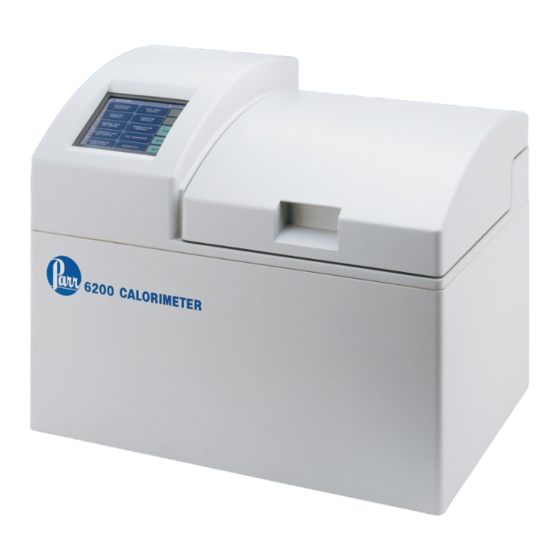
Advertisement
Quick Links
Advertisement

Subscribe to Our Youtube Channel
Summary of Contents for Parr Instrument 6200
- Page 1 6200 Calorimeter Operation Parr Instrument Company...
- Page 2 Goal Learn how to run a test on a Parr 6200 Calorimeter with a standard 1108 Oxygen Bomb.
- Page 3 Warning! It is important that the Operating Instruction Manual be read and understood (especially the safety instructions) before using the calorimeter. Failure to do so could result in catastrophic failure.
- Page 4 Step 1 Turn on the calorimeter The calorimeter will boot up to the main menu. Turn on the Oxygen Supply.
- Page 5 Step 2 Go to the Calorimeter Go to the Calorimeter Operation menu. Operation menu. Turn on the Heater and Turn on the Heater and Pump. Pump.
- Page 6 Note: The Start will be grayed out when the calorimeter is not ready to run a test. The jacket temperature must be at 30° C. Once the jacket temperature is at 30° C it will be an additional 10 minutes before the Start function is available.
- Page 7 Step 3 Prepare a Sample Tare (zero the weight of) a sample cup. Weigh a sample to the nearest .0001 g...
- Page 8 Step 4 Put the sample on the head Attach a fuse wire. The fuse wire should touch the top of a solid pellet. The fuse wire should not be buried in a powder or granulated sample. The fuse wire can touch a liquid ...
- Page 9 Step 5 Load the head into the bomb cylinder Place the head into the cylinder. Screw on the cap as far as it will go. Do not over-tighten.
- Page 10 Step 6 Place the Oxygen Fill Connection on to the 1108. Press the O2 Fill button on the Calorimeter Operation screen. Oxygen will flow into the 1108. A timer will count down the fill time. Pressing the O2 Fill key while the timer ...
- Page 11 Step 7 Fill the bucket with 2 liters (2000 ± .5 g) of water. Using the same amount of water each time is critical. Place the bucket inside the calorimeter. Note: There are three plastic pieces in the bottom of the air can that line up with the depressions in the bottom of the bucket.
- Page 12 Step 8 Using the bomb lifter position the bomb part way into the bucket. Attach the ignition wires to the terminals on the 1108 bomb head. Try to avoid getting your fingers wet.
- Page 13 Step 9 Lower the bomb the rest of the way into the bucket. Note that the bomb will sit on the embossed circle on the bottom of the bucket. Observe the bomb to make sure that there are no oxygen leaks. Do NOT continue if there are ...
- Page 14 Step 10 Close the lid making sure that neither the stirrer or the bucket thermistor are touching the 1108 bomb or bucket.
-
Page 15: Operating Mode
Step 11 Choose Standardization (calibration) or Determination (unknown samples) for Operating Mode. Press Start. Input the Sample ID. Input the Bomb ID. Input the Sample weight. Input the Spike weight (if spiking is turned on). ... - Page 16 Step 12 The test will automatically proceed through the following steps: Preperiod Cycle Fire the sample Post Period Cycle ...
- Page 17 Step 13 Results Once the calorimeter is finished with the post period cycle the results will print out on the printer or display on the touch screen. Once the test results have been printed or displayed the calorimeter will be ready for the next test once the next sample is ready.
- Page 18 Step 14 Open the lid and remove the bucket with the bomb. If another bomb and bucket combination is ready it may be put in at this time and go to step 8. Remove the 1108 bomb from the bucket and ...
- Page 19 Step 15 Fuse correction determination.* Remove the unburned remains of the fuse wire. Measure the unburned length and subtract from 10 cm. Multiply this by 2.3 cal/cm to get the result. The 45C10 Fuse Wire card may be used to ...
- Page 20 Step 16 Rinse the bomb head and cylinder. Use distilled water and rinse thoroughly. Save the rinse water for further tests as required. Dry the bomb head, cylinder and screw cap. The bomb is now ready to ...

Need help?
Do you have a question about the 6200 and is the answer not in the manual?
Questions and answers